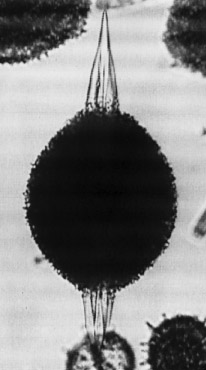 Spongatractus
pachystylus (Ehrenberg)
Spongatractus
pachystylus (Ehrenberg) Spongatractus
pachystylus (Ehrenberg)
Spongatractus
pachystylus (Ehrenberg)Spongosphaera pachystyla Ehrenberg, 1873, p.256; 1875, pl.26, fig.3
Spongatractus pachystylus (Ehrenberg), Sanfilippo and Riedel, 1973, p.519, pl.2, figs.4-6, pl.25, fig.3 (with synonymy)
Thick-walled ellipsoidal shell, covered completely by one thick or several layers of spongy meshwork, and joined to a spherical, double medullary shell by bars approximately in the equatorial plane. Additionally, there are two bars collinear with the two robust, bladed spines, which are variable in form and size. Commonly the polar spines are as long as the major diameter of the cortical shell, with a distinct change in contour midway, from parallel proximally to tapered distally. The external spongy layer commonly obscures the medullary shell - only when this layer is thinned by dissolution can the medullary shell be observed. Small thorns may be present on the proximal part of the polar spines. These are remnants of the spongy cortical shell, indicating the extent (major diameter) of the cortical shell before dissolution. (Sanfilippo, unpubl. data)
Based on 35 specimens. Major diameter of cortical shell 160-230 µm; minor diameter 105-180 µm. Length along major axis including the spines 270-465 µm (Sanfilippo, unpubl. data).
S. pachystylus is distinguished from S. balbis, its ancestor, by greater development of the outer spongy layer, and from the Axoprunum pierinae (Clark and Campbell) group (Sanfilippo and Riedel, 1973, p.488) by the distinctively bladed spines and presence of the spongy layer (Sanfilippo, unpubl. data).
The spines are constantly robust, and show a characteristic change in contour from parallel-sided proximally to tapered distally. The development of the spongy layer on the cortical shell varies in thickness, but by definition is always more than three layers thick in early forms--later forms may have only one thick, unzoned layer (Sanfilippo, unpubl. data).
S. pachystylus is found at all middle Eocene localities in 30°S to 35°N. It evolved from Spongatractus balbis within the Phormocyrtis striata striata Zone. Its morphotypic last appearance lies within the Podocyrtis goetheana Zone.
S. pachystylus evolved from S. balbis and left no known descendants. In the latest part of its range, S. pachystylus is accompanied by an ellipsoidal to discoidal form that may be related. It has a double medullary shell and a marginal pylome, and is covered with dense spongy meshwork obscuring the details of a phacoid shell similar in size to that of this species (Sanfilippo et al., 1985).